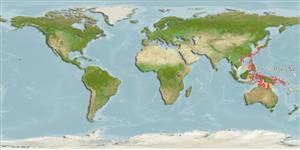Actinopterígios (peces con aletas radiadas) >
Perciformes (Perch-likes) >
Pomacanthidae (Angelfishes)
Etymology: Centropyge: Greek, kentron = sting + Greek, pyge = tail (Ref. 45335).
Medioambiente / Clima / Gama
Ecología
; marino asociado a arrecife; no migratorio; rango de profundidad 10 - 40 m (Ref. 48391). Tropical, preferred ?
Western Pacific: Japan to the northern Philippines.
Tamaño / Peso / Age
Maturity: Lm ? range ? - ? cm
Max length : 12.0 cm NG macho / no sexado; (Ref. 47838)
Espinas dorsales (total): 14; Radios blandos dorsales (total): 16; Espinas anales 3; Radios blandos anales: 15.
Inhabits steep outer reef slopes (Ref. 9710); in ledges and caves (Ref. 48391). Shy species, not easily approached at close range (Ref. 4537). Usually observed singly, almost always upside down in reef caves (Ref. 47838); also forms pairs or small groups (Ref. 48391). Natural diet unknown (Ref. 48391). Sometimes forms hybrids with Centropyge multifasciata (Ref. 48391). Occasionally exported through the aquarium trade.
Life cycle and mating behavior
Madurez | Reproducción | Puesta | Huevos | Fecundidad | Larva
Pyle, R., 2001. Pomacanthidae: Angelfishes. p. 3266-3286. In K.E. Carpenter and V.H. Niem (eds.) FAO species identification guide for fishery purposes. The living marine resources of the Western Central Pacific. Volume 5. Bony fishes part 3 (Menidae to Pomacentridae). Rome, FAO. (Ref. 48391)
IUCN Red List Status (Ref. 115185)
CITES (Ref. 94142)
Not Evaluated
Threat to humans
Harmless
Human uses
Acuario: Comercial
Más información
ReferenciasAcuiculturaPerfil de acuiculturaRazasGenéticaFrecuencias de alelosheritabilidadEnfermedadesProcesamientoMass conversion
ColaboradoresImágenesStamps, CoinsSonidosCiguateraVelocidadTipo de nataciónSuperficie branquialOtolitosCerebrosVisión
Herramientas
Special reports
Download XML
Fuentes de Internet
